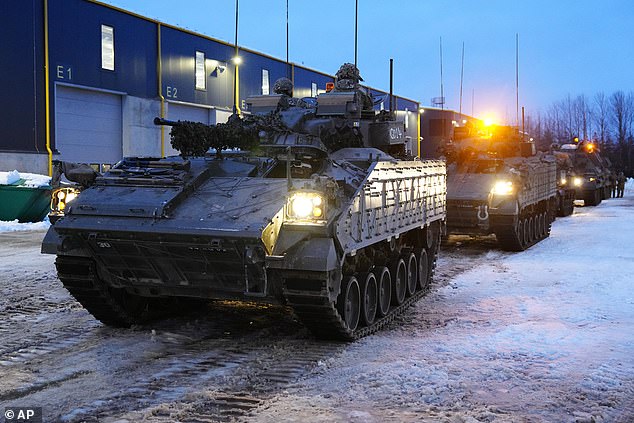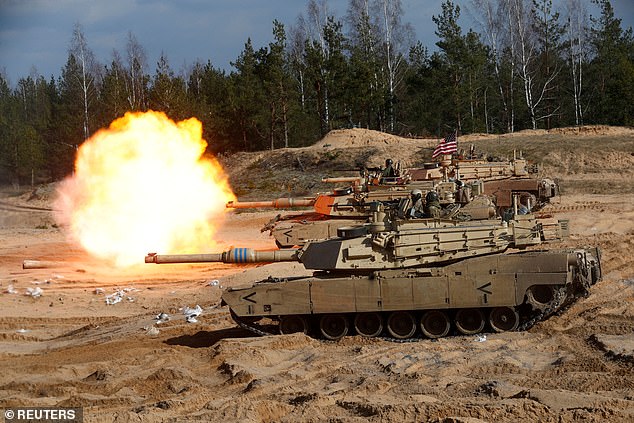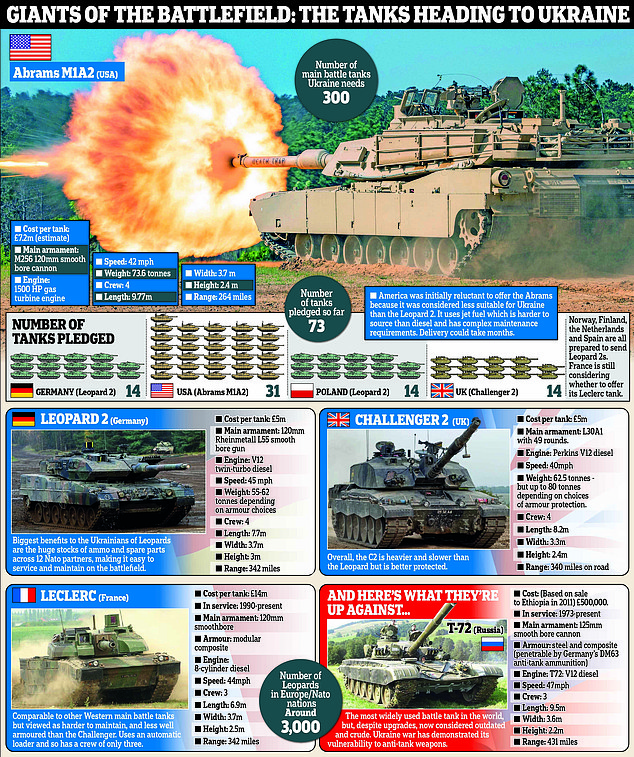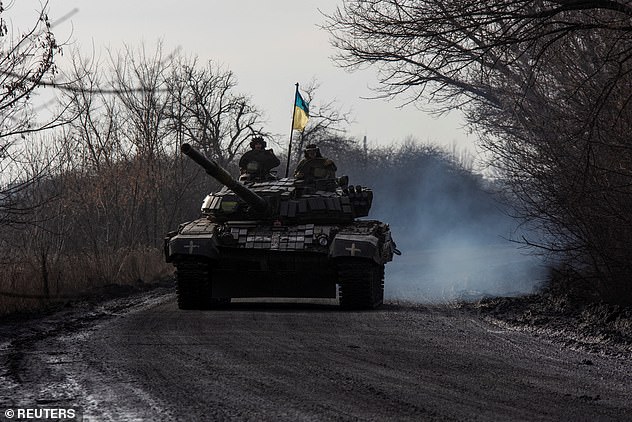Ukraine now faces the logistical nightmare of receiving tanks and training crews.
>
Ukraine is in a celebratory mood after finally convincing Western leaders to ditch dozens of sophisticated tanks that they believe will pack a big punch in Vladimir Putin’s invasion and help win the war.
But their dreams will soon meet reality as the months-long wait for the procurement, refurbishment and delivery of the military vehicles begins, along with an intensive training program.
The process could even leave Ukraine stranded without high-tech weaponry until Moscow orders its long-awaited triple spring offensive, which could turn out to be a pivotal moment in the conflict.
The US doesn’t even have a ready supply of M1 Abrams tanks to deliver and will need to procure part of its fleet, while German defense minister Boris Pistorius said its Leopard 2 tanks won’t be ready until late March or early April. .
A Leopard 2 main battle tank fires fog grenades during exercises in Germany. A fleet of tanks will soon be sent to Ukraine.
By then, it is anticipated that Russia will have launched a major assault, ordering forces south of Belarus, north of Crimea and east of Donbas to encircle and strangle Kyiv’s forces.
Putin already issued a furious response to the deal today by firing dozens of missiles at Ukraine, which was forced to issue a nationwide airstrike alert.
The reprisals indicate that the war will intensify thanks to the NATO move and the Kremlin will not be left waiting for the tanks to arrive.
Tanks will no longer have their full impact by spring at the earliest, meaning Western hesitation may have cost Ukraine a decisive blow to Moscow.
George Barros of the Institute for the Study of War said news week: ‘The Ukrainians were signaling their intention to conduct offensive operations through the winter, but the lack of Western security assistance has degraded their ability to do so.’
It was a similar story with the HIMARS weapon system, which came after a series of Russian offensives and delayed the liberation of Kherson.
Barros added: “It is the hesitation in some Western capitals to provide the necessary systems immediately, not the provision of the weapons itself, that is acting to prolong this war.”
The fact that the German Leopard 2, the US M1 Abrams and the British Challenger 2 each require different training, different maintenance and will arrive sporadically in the coming months will only complicate matters further.

Armored vehicles from Britain prepare to move into Estonia after being engaged by Kyiv forces.

A US Army M1 Abrams tank fires during NATO exercises in Latvia

Initially, Ukraine is likely to focus on filling its stocks with a fleet of only Leopard or Leopard 2 tanks to avoid the difficulty of operating multiple vehicles together that are not designed to do so.
Training of Ukrainian troops on German Marder infantry fighting vehicles will begin in the next few days, Pistorius said today, “and for Ukrainian soldiers who will be trained on the Leopard it will be a bit later.”
It will force the Kyiv army to completely rethink its current strategy and quickly adapt to new technology, having relied on Soviet-era T-72 tanks during the war.
They will also need to expand their maintenance and production facilities to accommodate the new, most advanced vehicles in the world.
Brad Martin, director of the RAND Institute for Supply Chain Security, told BBC Radio 4’s Today programme: “Unfortunately, it means that each of these capabilities will need their own supply chains because they are different, their parts are different, The maintenance requirements are different.
‘I don’t know if it’s such a big challenge that it can’t be met, but all things being equal, it would be better to have common systems, but they are working with what they have.
‘The United States has a number of Abrams tanks and some of them would have to be refitted for export… they certainly aren’t ready to go, work will have to be done to get them. of them ready to be deployed.
‘A lot of it is quite complicated and sophisticated stuff and it takes time to learn how to deal with it, training will be a very big issue.
“Supply chains and parts procurement take time, and those two things together will be a challenge.”
In Washington, senior officials have privately expressed dismay at Germany’s attempts to link the Abrams tanks to the Leopard delivery.
A senior administration official told reporters that the bosses did not believe the Abrams tanks were a positive for Ukraine because they are difficult to operate and maintain.

Ukrainian soldiers are seen riding a Soviet-era T-72 tank, widely used in the ongoing conflict, in the Donetsk region on January 20.
But Germany didn’t want to go it alone, the official said, leading Americans to wonder if there was a deeper reason in Berlin that had to do with the symbolism of German tanks rolling across eastern Europe for a country still scarred by the beginning of World War II.
At the same time, US officials were trying to respond to Ukraine’s clamor for tanks while also insisting to the Ukrainians that there are limits to long-term assistance.
Ukraine’s military tactics will also have to adapt to its new toys.
The tanks must get close enough to punch holes through the enemy lines, which means the infantry must get closer to the Russian positions.
Engineers will be required to help the tanks cross the rivers and artillery will need to cover the flanks to defend against a potential counter-attack, along with air defense protecting the vehicles from above.
The tanks will also need to be transported to the front by low-bed trucks, which will also require their own protection.

German Defense Minister Boris Pistorius is seen a day after he finally agreed to supply Ukraine with tanks.
On top of this, it remains to be seen if the supply is large enough to do what Ukraine needs.
Western countries have so far given “no clear indication” of how many tanks will be delivered, an adviser to the country’s defense ministry said.
Yuriy Sak told the BBC Radio 4 Today programme: ‘We need 300 to 400 tanks for this to be a game changer.
‘This coalition of tanks consisting of different countries, we do not have a clear indication of how many tanks each country will provide. We have communicated to our partners that this is the number we need.
‘If you want to stop the missile terror, you need to receive the weapons that will enable us to defeat the enemy on the battlefield.
“The sooner we defeat Russia on the battlefield using Western weapons, the sooner we can stop this missile terror and restore peace.”
So far the number of tanks offered is in the dozens rather than hundreds, though deliveries could continue.
Ukrainian officials are now requesting missiles and long-range aircraft, but it is likely to be a similar wait to their previous requests for military assistance.
Presidential adviser Mikhailo Podolyak told The Daily Telegraph: “Right now we are seeing a sharp change in sentiment among the political elites of European countries… we will reach, I am sure, without a doubt, an agreement on long-range missiles “.
Zelensky said: ‘In general, I am grateful to the world for its support of Ukraine. But if we are talking frankly and honestly with you, then the number of tanks and the delivery time are of crucial and critical importance, compared to the decision that has been made.
‘We have approved boxes of weapons to be sent to us, but we have not received them yet.
Sometimes the delivery of the weapons takes months, you understand?
